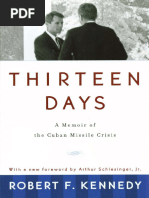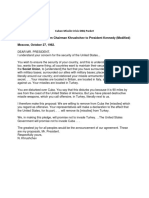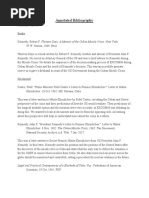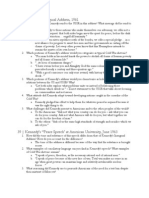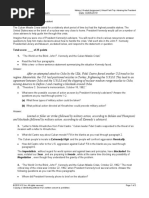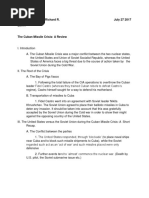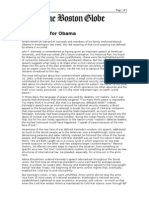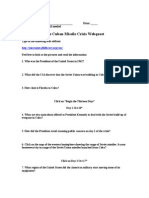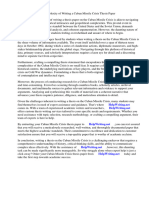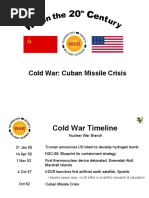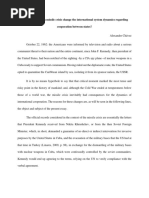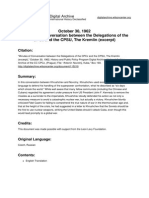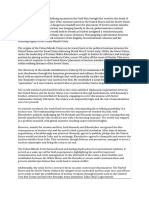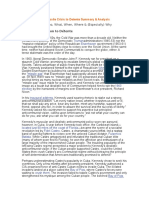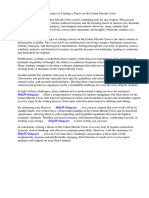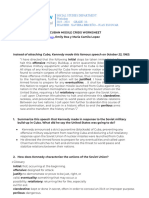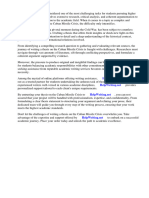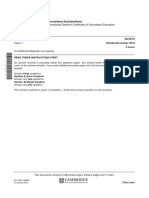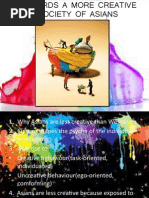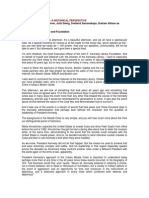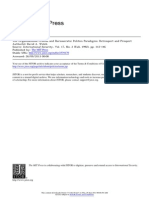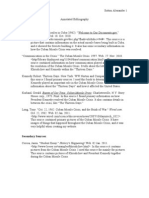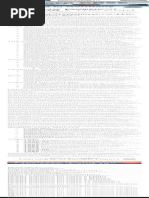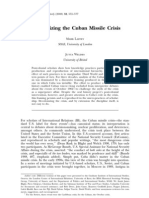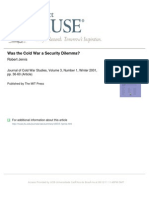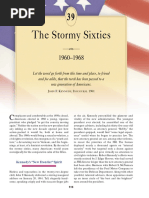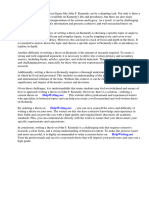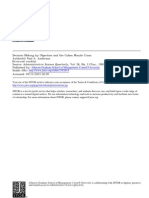Cuban Missile Crisis
Cuban Missile Crisis
Uploaded by
ContrinseCopyright:
Available Formats
Cuban Missile Crisis
Cuban Missile Crisis
Uploaded by
ContrinseOriginal Title
Copyright
Available Formats
Share this document
Did you find this document useful?
Is this content inappropriate?
Copyright:
Available Formats
Cuban Missile Crisis
Cuban Missile Crisis
Uploaded by
ContrinseCopyright:
Available Formats
Directions: Answer the boxes on the right side of the paper from President Kennedy’s speech.
The Cuban Missile Crisis - - Speech by John F. Kennedy
On October 22, 1962, the White House announced that President John F. Kennedy would deliver a speech of
the "highest national urgency." That evening, the president went on television and radio to inform the
American people about the presence of Soviet missile sites in Cuba and his plans to remove them. As you
read this excerpt from Kennedy's speech, think about why he demanded that the Soviets withdraw their
missiles from Cuba.
Good evening, my fellow citizens. This
Government, as promised, has maintained the Why does Kennedy fear the missile
closest surveillance of the Soviet military build-up bases?
on the island of Cuba. Within the past week
unmistakable evidence has established the fact
that a series of offensive missile sites is now in
preparation on that imprisoned island. The
purposes of these bases can be none other than to
provide a nuclear strike capability against the
Western Hemisphere.
Upon receiving the first preliminary hard Why do you think Kennedy told
information of this nature last Tuesday morning Americans how far the missiles could
(October 16) at 9:00 A.M., I directed that our
surveillance be stepped up. And having now travel?
confirmed and completed our evaluation of the
evidence and our decision on a course of action,
this Government feels obliged to report this new
crisis to you in fullest detail.
The characteristics of these new missile sites
indicate two distinct types of installations.
Several of them include medium-range ballistic
missiles capable of carrying a nuclear warhead for
a distance of more than 1,000 nautical miles.
Each of these missiles, in short, is capable of
striking Washington, D.C., the Panama Canal,
Cape Canaveral, Mexico City, or any other city in
the southeastern part of the United States, in How did Kennedy try to make
Central America, or in the Caribbean area. . . .
Americans feel better about themselves in
This nation is prepared to present its case this Cold War conflict?
against the Soviet threat to peace, and our own
proposals for a: peaceful world, at any time and
in any forum. . . .
We
. have in the past made strenuous efforts
to limit the spread of nuclear weapons. We have
proposed the elimination of all arms and
military bases in a fair and effective
disarmament treaty. We are prepared to
discuss new proposals for the removal of
tensions on both sides - including the possibili- How has Cuba been affected by the
ties of a genuinely independent Cuba, free to Cold War?
determine its own destiny. We have no wish to
war with the Soviet Union, for we are a
peaceful people who desire to live in peace with
all other peoples.
But it is difficult to settle or even discuss these
problems in an atmosphere of intimidation.
That is why this latest Soviet threat-or any
other threat which is made either 24
independently
According to Kennedy’s speech, what
or in response to our actions this week-must is the goal of America and how has
and will be met with determination. . . .
The path we have chosen for the present is this been achieved?
full of hazards, as all paths are; but it is the
one most consistent with our character and
courage as a nation and our commitments
around the world. The cost of freedom is
always high-but Americans have always paid
it. And one path we shall never choose, and
that is the path of surrender or submission.
Our goal is not the victory of might but the
vindication of right-not peace at the expense
of freedom, but both peace and freedom, here
in this Hemisphere and, we hope, around the
world. God willing, that goal will be achieved.
from John Kennedy, U.S., Department of State, Bulletin, Volume XLVII, No. 1220 (November
12,1962),715-720. (Address delivered from the White House by T.V. and radio on October 22, 1962.)
Reprinted in David L. Larson, ed., The "Cuban Crisis" of 1962 (Boston: Houghton Mifflin, 1963),41-46
Directions: Answer the following questions using Herbert Block’s political cartoon
Herbert Block drew this political cartoon shortly after the Cuban missile crisis, the most serious U.S.-Soviet
confrontation. Notice that, unlike many American politicians and journalists who were severely critical of the Soviet
leader at the time, Block depicts Nikita Khrushchev as an equal of President Kennedy in struggling to contain nuclear
war.
"Let's Get a Lock for This Thing"
from Herblock: A Cartoonist's Life (Lisa Drew
Books/Macmillan, 1993).
1. How did Herbert Block show that both
Kennedy and Khrushchev struggling to contain
nuclear war?
2. What is the significance (importance) of
nuclear war’s hands?
25
You might also like
- DBQ Primary Source Analysis LessonDocument8 pagesDBQ Primary Source Analysis Lessonapi-282255709No ratings yet
- Thirteen Days - Robert F KennedyDocument146 pagesThirteen Days - Robert F Kennedymara gimeno50% (2)
- Cuban Missile Crisis DBQ PacketDocument6 pagesCuban Missile Crisis DBQ Packetapi-376758939No ratings yet
- Annotated BibliographyDocument15 pagesAnnotated Bibliographyaaron_hamilton42017No ratings yet
- Annotated BibliographyDocument10 pagesAnnotated BibliographyAditya BhaveNo ratings yet
- Annotated BibliographyDocument15 pagesAnnotated Bibliographyaaron_hamilton42017No ratings yet
- The Cuban Missile Crisis October 1962Document2 pagesThe Cuban Missile Crisis October 1962Idrissa BachirouNo ratings yet
- Cold War ECDocument4 pagesCold War ECSahil V ShahNo ratings yet
- Cuban Missle Crisis ResearchDocument4 pagesCuban Missle Crisis Researchtazwarabrar211No ratings yet
- Cuban Missile Crisis Cold War DBQ AnnotatedDocument4 pagesCuban Missile Crisis Cold War DBQ AnnotatedMelody ConklinNo ratings yet
- Kami Export - Lisbeth Pacheco Escorcia - Cuban Missile Crisis Student Materials - 7Document5 pagesKami Export - Lisbeth Pacheco Escorcia - Cuban Missile Crisis Student Materials - 7Lisbeth Pacheco EscorciaNo ratings yet
- Cuban Missile Crisis Student MaterialsDocument5 pagesCuban Missile Crisis Student MaterialsOperation BiteWolfNo ratings yet
- Cuban Missile Crisis Research Paper ThesisDocument6 pagesCuban Missile Crisis Research Paper Thesisafknvhdlr100% (2)
- Cuban Missile Crisis Thesis QuestionsDocument7 pagesCuban Missile Crisis Thesis Questionstammymitchellfortwayne100% (2)
- Cuban Missile Crisis Lesson Plan - StanfordDocument6 pagesCuban Missile Crisis Lesson Plan - Stanfordapi-229785206No ratings yet
- Final ProjectDocument9 pagesFinal ProjectCaleb thomasNo ratings yet
- Procurement AnalysisDocument30 pagesProcurement Analysisasit chatterjeeNo ratings yet
- Fulltext PDFDocument40 pagesFulltext PDFresalviniNo ratings yet
- 5 01Document2 pages5 01Edward 42 NigmaNo ratings yet
- President John F. Kennedy's Inaugural Address Friday, January 20, 1961Document3 pagesPresident John F. Kennedy's Inaugural Address Friday, January 20, 1961Tanish KothariNo ratings yet
- Basic Gov ProposalDocument4 pagesBasic Gov ProposalStephen BarbadilloNo ratings yet
- Primary Source Analysis, J.F. Kennedy's Cuban Missile Crisis Address (1962) FinalDocument5 pagesPrimary Source Analysis, J.F. Kennedy's Cuban Missile Crisis Address (1962) Finallukemwangi37No ratings yet
- Cuban Missile Crisis Student Materials 7Document5 pagesCuban Missile Crisis Student Materials 7api-546255049No ratings yet
- The Cold War & US Diplomacy (Final Draft) 4/30/2012Document6 pagesThe Cold War & US Diplomacy (Final Draft) 4/30/2012KT100% (1)
- Cuban Missle CrisisDocument3 pagesCuban Missle CrisiscaetispogNo ratings yet
- 02-04-08 Boston Globe-JFK's Torch For Obama by James CarrollDocument2 pages02-04-08 Boston Globe-JFK's Torch For Obama by James CarrollMark WelkieNo ratings yet
- Ush Chapter 28Document20 pagesUsh Chapter 28D KangNo ratings yet
- The Century - Poisoned DreamsDocument1 pageThe Century - Poisoned DreamsCharles CogginsNo ratings yet
- Cuban Missiles CrisisDocument2 pagesCuban Missiles CrisisEdu PurposeNo ratings yet
- Research Paper The Cuban Missile CrisisDocument6 pagesResearch Paper The Cuban Missile Crisisapi-512512524No ratings yet
- 7b Formative - U.S. Response To Cold War EventsDocument3 pages7b Formative - U.S. Response To Cold War EventsheslepparkerNo ratings yet
- ThecubanmissilecrisiscoldwarwebquestgreatwebsiteDocument6 pagesThecubanmissilecrisiscoldwarwebquestgreatwebsiteapi-266309582No ratings yet
- CW 7 - The Cuban Missile CrisisDocument5 pagesCW 7 - The Cuban Missile Crisismohanwadia15No ratings yet
- I'll Get Back to You: The Dyscommunication Crisis: Why Unreturned Messages Drive Us Crazy and What to Do About ItFrom EverandI'll Get Back to You: The Dyscommunication Crisis: Why Unreturned Messages Drive Us Crazy and What to Do About ItNo ratings yet
- Cuban Missile Crisis Thesis PaperDocument7 pagesCuban Missile Crisis Thesis Papermeganfosteromaha100% (2)
- Cold War: Cuban Missile CrisisDocument39 pagesCold War: Cuban Missile CrisiskawsarNo ratings yet
- NHD Research PaperDocument14 pagesNHD Research Paperapi-461594391No ratings yet
- Essay Cuban Missile CrisisDocument3 pagesEssay Cuban Missile CrisisPaulaNo ratings yet
- Why Did The Cuban Missile Crisis Change The International System Dynamics Regarding Cooperation Between StatesDocument4 pagesWhy Did The Cuban Missile Crisis Change The International System Dynamics Regarding Cooperation Between StatesAlexander ChávezNo ratings yet
- A Good Thesis Statement For The Cuban Missile CrisisDocument7 pagesA Good Thesis Statement For The Cuban Missile Crisiskimberlyjonesshreveport100% (2)
- October 30, 1962 Minutes of Conversation Between The Delegations of The CPCZ and The Cpsu, The Kremlin (Excerpt)Document4 pagesOctober 30, 1962 Minutes of Conversation Between The Delegations of The CPCZ and The Cpsu, The Kremlin (Excerpt)api-281488375No ratings yet
- The Cuban Missile CrisisDocument2 pagesThe Cuban Missile CrisissatvikajadhavNo ratings yet
- Detente SummaryDocument15 pagesDetente SummaryIsmail M HassaniNo ratings yet
- DEFCON-2: Standing on the Brink of Nuclear War During the Cuban Missile CrisisFrom EverandDEFCON-2: Standing on the Brink of Nuclear War During the Cuban Missile CrisisRating: 4 out of 5 stars4/5 (2)
- Thesis For Cuban Missile CrisisDocument8 pagesThesis For Cuban Missile Crisisbsrf4d9d100% (3)
- Cuban Missile Crisis Research EssayDocument7 pagesCuban Missile Crisis Research EssayShental RohanNo ratings yet
- Backround:: Cuban Missile CrisisDocument14 pagesBackround:: Cuban Missile Crisisapi-282286866No ratings yet
- The Problem of Acceptable Risk in The Cuban Missile Crisis Settlement PDFDocument45 pagesThe Problem of Acceptable Risk in The Cuban Missile Crisis Settlement PDFLawrence Wesley MwagwabiNo ratings yet
- Kennedy, Johnson and The Limits of Power, 1961-1968. Chapter 16Document10 pagesKennedy, Johnson and The Limits of Power, 1961-1968. Chapter 16Marina DinuNo ratings yet
- Cuban Missile Crisis Actual PDFDocument8 pagesCuban Missile Crisis Actual PDFhimani prajapatiNo ratings yet
- Cuban Missile Crisis Essay ThesisDocument5 pagesCuban Missile Crisis Essay Thesisafbwrszxd100% (2)
- Cuban CrisisDocument22 pagesCuban CrisisMatthew WeeNo ratings yet
- Thesis Statements For The Cuban Missile CrisisDocument4 pagesThesis Statements For The Cuban Missile Crisispzblktgld100% (1)
- Cuban Crisis - Onelly 9-2Document14 pagesCuban Crisis - Onelly 9-2Onells ..No ratings yet
- 6ced92418abc59ed18d30f4778cfc9b9_MIT17_40F17_CubnMisileCrisDocument8 pages6ced92418abc59ed18d30f4778cfc9b9_MIT17_40F17_CubnMisileCrissmaazNo ratings yet
- Copia de CubanMissilecrisisDocument7 pagesCopia de CubanMissilecrisisemilyroaNo ratings yet
- Problemsolvers IntegratingotherareasDocument3 pagesProblemsolvers Integratingotherareasapi-356822645No ratings yet
- Thesis Cuban Missile CrisisDocument5 pagesThesis Cuban Missile CrisisPaySomeoneToWritePaperUK100% (2)
- Kennedy's Presidency, The Cuban Missile Crisis.: Dealing With Arms and The U.S.S.RDocument4 pagesKennedy's Presidency, The Cuban Missile Crisis.: Dealing With Arms and The U.S.S.RDiana DianaDdNo ratings yet
- History Course WorkDocument3 pagesHistory Course WorkRauf GaralovNo ratings yet
- Cambridge International General Certificate of Secondary EducationDocument12 pagesCambridge International General Certificate of Secondary EducationAncient SignatureNo ratings yet
- Book-1 Political Science MCQs For Term 1 (EM)Document15 pagesBook-1 Political Science MCQs For Term 1 (EM)Garima ShahNo ratings yet
- CtpsDocument88 pagesCtpsSyafiqah NajibNo ratings yet
- Possible Edexcel Gcse History Questions - 2Document12 pagesPossible Edexcel Gcse History Questions - 2nftsaremyaddictionNo ratings yet
- Cuban Missile Crisis A Historical PerspectiveDocument19 pagesCuban Missile Crisis A Historical PerspectiveAdi JorjNo ratings yet
- The Organizational Process and Bureaucratic Politics Paradigms - Retrospect and ProspectDocument36 pagesThe Organizational Process and Bureaucratic Politics Paradigms - Retrospect and ProspectAnonymous QvdxO5XTRNo ratings yet
- Annotated Bibliography On The Cuban Missile Crisis Sutton AlexanderDocument6 pagesAnnotated Bibliography On The Cuban Missile Crisis Sutton AlexanderSutton AlexanderNo ratings yet
- PDF A Concise History of U S Foreign Policy 4th Edition Joyce P. Kaufman downloadDocument55 pagesPDF A Concise History of U S Foreign Policy 4th Edition Joyce P. Kaufman downloadmoatzobertjg100% (1)
- Class 12 Political Science Notes Chapter 1 The CoDocument2 pagesClass 12 Political Science Notes Chapter 1 The CoDipanshu SharmaNo ratings yet
- The Cold War Imp Q&aDocument30 pagesThe Cold War Imp Q&aManas DasNo ratings yet
- Book Club-Consolidated DocumentDocument38 pagesBook Club-Consolidated Documentapi-458181868No ratings yet
- Decolonizing The Cuban Missile CrisisDocument23 pagesDecolonizing The Cuban Missile CrisisshihyuatsheffyNo ratings yet
- GCSE History Scheme of Work Paper 2 Option P4 Superpower Relations v2Document4 pagesGCSE History Scheme of Work Paper 2 Option P4 Superpower Relations v2fatepatelgaNo ratings yet
- Cuban MissileDocument70 pagesCuban MissilemarutheshNo ratings yet
- PHD Thesis Us Foreign PolicyDocument7 pagesPHD Thesis Us Foreign Policydwt5trfn100% (2)
- CH 33 Sec 4 - The Cold War Divides The World PDFDocument6 pagesCH 33 Sec 4 - The Cold War Divides The World PDFMrEHsiehNo ratings yet
- A Start On History IADocument3 pagesA Start On History IAAlan LaFraeNo ratings yet
- Was The Cold War A Security Dilemma?: Robert JervisDocument26 pagesWas The Cold War A Security Dilemma?: Robert JervisLaeticia MarisNo ratings yet
- Americanpageantchapter39 PDFDocument30 pagesAmericanpageantchapter39 PDFferchojuanesNo ratings yet
- The Cold War Imp Q&aDocument31 pagesThe Cold War Imp Q&aManas DasNo ratings yet
- Country BoyDocument95 pagesCountry BoyAllan SorianoNo ratings yet
- John F Kennedy Term PaperDocument8 pagesJohn F Kennedy Term Papercuutpmvkg100% (1)
- Primary Source Citations Word 2Document2 pagesPrimary Source Citations Word 2api-196066649No ratings yet
- (Template) BrainPop Cold WarDocument6 pages(Template) BrainPop Cold Warlhoule1031No ratings yet
- Assignment 1Document1 pageAssignment 1rakshjay27No ratings yet
- Rhetorical Analysis of President Kennedy Final DraftDocument5 pagesRhetorical Analysis of President Kennedy Final Draftapi-325641098100% (2)
- Cuban Missile Decision MakingDocument23 pagesCuban Missile Decision MakingDavinder SinghNo ratings yet
- World History 2147, Shayaan.Document15 pagesWorld History 2147, Shayaan.Ifrah DarNo ratings yet
- ACC Background Guide - UBMUN2018Document13 pagesACC Background Guide - UBMUN2018Намуун ТөрхүүNo ratings yet

